Do you have a question about the SunSynk 6K-SG02LP1 and is the answer not in the manual?
Critical warning about high risk of fire or electrocution during installation.
Covers manual reading, professional installation, grounding, breakers, RCDs, and waiting periods.
Identifies key components of the 3.5/5.5kW and 8.8kW inverter units.
Details interactive, compatible, and configurable features of the inverter.
Highlights secure features like overload and short-circuit protection.
Lists various applications where the inverter can be utilized.
Details technical specifications for 3.6kW and 5.5kW inverter models.
Details technical specifications for 5kW, 6kW, 7.6kW, and 8kW inverter models.
Illustrates the system diagram and shows the inverter's efficiency curve.
Provides guidelines on where NOT to install the inverter and other considerations.
Details instructions and clearance requirements for mounting the inverter.
Explains battery connection for 3.6/5.5kW and 8kW models, including cable size.
Outlines connection steps for Lithium batteries and recommended surge protectors.
Details the connection of the battery temperature sensor and its importance.
Provides notes and shows views of AC connection terminals for different models.
Details steps for AC connection and recommends an AC surge protector.
Explains the installation and function of the CT coil for "Zero Export" feature.
Describes the mandatory earth connection for electric shock prevention.
Details earth bonding requirements for hybrid systems and island mode setup.
Explains PV connection for 3.6/5.5kW and 8.8kW models, including MPPTs.
Details connection of 5.5 kW PV panels via MC4 connectors.
Explains the inverter's LCD display elements and LED indicators.
Describes how to turn the inverter on/off and navigate to the home page.
Explains the information displayed on the Status page for various parameters.
Illustrates the system's energy flow and power distribution.
Guides on accessing and navigating the Setup page for various settings.
Details the step-by-step process for adjusting the inverter's time and date.
Explains how to set company name, activate/deactivate the beeper, and adjust auto dim.
Describes how to perform factory resets and set lock codes for settings.
Guides on configuring battery settings like capacity, charge, and discharge limits.
Provides important notes on battery protection and configuration for charging.
Explains how to connect and use a generator with the Sunsynk inverter, including auto-start.
Details settings for inverter shutdown based on battery voltage and charge status.
Guides on setting up lithium batteries and their communication protocols.
Explains how to check lithium battery BMS communication and lists approved batteries.
Provides important guidelines for battery charging, discharging, and cable selection.
Details how to program charge and discharge times and export power settings.
Provides examples for zero export and prioritized charging/discharging scenarios.
Explains how to configure grid type, frequency, and voltage settings.
Details specific parameters for voltage and frequency trip/ride-through settings.
Guides on configuring inverters for master/slave operation and Modbus settings.
Explains single and three-phase paralleling configurations and important setup notes.
Discusses data cable connection, communication errors, and common questions for paralleling.
Shows how to access and interpret daily, monthly, and yearly solar power generation data.
Shows how to access and interpret daily, monthly, and yearly grid power import/export data.
Guides on selecting MPPT inputs for wind turbine operation.
Details maximum current based on voltage and important safety notes for wind turbines.
Explains settings for generator input, auxiliary load, and micro inverter usage.
Describes how to enable generator/grid peak shaving and set the power value.
Lists common fault codes, their descriptions, and suggested solutions.
Provides further details on specific fault codes related to voltage, frequency, and battery.
Shows the mapping between fault information, instructions, and internal structure codes.
Details the step-by-step sequence for powering up and shutting down the inverter.
Provides guidance on programming and setting up the inverter after powering up.
Explains the GFDI fault detection mechanism and error reporting.
Outlines essential maintenance tasks like cleaning fans and air ducts.
Defines the pin configuration for RS485 and CAN communication ports.
Notes that inverters sold in Australia are set to default Australian standards.
States compatibility with the SolarMan app via Wifi or GSM data logger.
Recommends using an RCD of Type A with 30mA sensitivity for connected circuits.
Critical warning about high risk of fire or electrocution during installation.
Covers manual reading, professional installation, grounding, breakers, RCDs, and waiting periods.
Identifies key components of the 3.5/5.5kW and 8.8kW inverter units.
Details interactive, compatible, and configurable features of the inverter.
Highlights secure features like overload and short-circuit protection.
Lists various applications where the inverter can be utilized.
Details technical specifications for 3.6kW and 5.5kW inverter models.
Details technical specifications for 5kW, 6kW, 7.6kW, and 8kW inverter models.
Illustrates the system diagram and shows the inverter's efficiency curve.
Provides guidelines on where NOT to install the inverter and other considerations.
Details instructions and clearance requirements for mounting the inverter.
Explains battery connection for 3.6/5.5kW and 8kW models, including cable size.
Outlines connection steps for Lithium batteries and recommended surge protectors.
Details the connection of the battery temperature sensor and its importance.
Provides notes and shows views of AC connection terminals for different models.
Details steps for AC connection and recommends an AC surge protector.
Explains the installation and function of the CT coil for "Zero Export" feature.
Describes the mandatory earth connection for electric shock prevention.
Details earth bonding requirements for hybrid systems and island mode setup.
Explains PV connection for 3.6/5.5kW and 8.8kW models, including MPPTs.
Details connection of 5.5 kW PV panels via MC4 connectors.
Explains the inverter's LCD display elements and LED indicators.
Describes how to turn the inverter on/off and navigate to the home page.
Explains the information displayed on the Status page for various parameters.
Illustrates the system's energy flow and power distribution.
Guides on accessing and navigating the Setup page for various settings.
Details the step-by-step process for adjusting the inverter's time and date.
Explains how to set company name, activate/deactivate the beeper, and adjust auto dim.
Describes how to perform factory resets and set lock codes for settings.
Guides on configuring battery settings like capacity, charge, and discharge limits.
Provides important notes on battery protection and configuration for charging.
Explains how to connect and use a generator with the Sunsynk inverter, including auto-start.
Details settings for inverter shutdown based on battery voltage and charge status.
Guides on setting up lithium batteries and their communication protocols.
Explains how to check lithium battery BMS communication and lists approved batteries.
Provides important guidelines for battery charging, discharging, and cable selection.
Details how to program charge and discharge times and export power settings.
Provides examples for zero export and prioritized charging/discharging scenarios.
Explains how to configure grid type, frequency, and voltage settings.
Details specific parameters for voltage and frequency trip/ride-through settings.
Guides on configuring inverters for master/slave operation and Modbus settings.
Explains single and three-phase paralleling configurations and important setup notes.
Discusses data cable connection, communication errors, and common questions for paralleling.
Shows how to access and interpret daily, monthly, and yearly solar power generation data.
Shows how to access and interpret daily, monthly, and yearly grid power import/export data.
Guides on selecting MPPT inputs for wind turbine operation.
Details maximum current based on voltage and important safety notes for wind turbines.
Explains settings for generator input, auxiliary load, and micro inverter usage.
Describes how to enable generator/grid peak shaving and set the power value.
Lists common fault codes, their descriptions, and suggested solutions.
Provides further details on specific fault codes related to voltage, frequency, and battery.
Shows the mapping between fault information, instructions, and internal structure codes.
Details the step-by-step sequence for powering up and shutting down the inverter.
Provides guidance on programming and setting up the inverter after powering up.
Explains the GFDI fault detection mechanism and error reporting.
Outlines essential maintenance tasks like cleaning fans and air ducts.
Defines the pin configuration for RS485 and CAN communication ports.
Notes that inverters sold in Australia are set to default Australian standards.
States compatibility with the SolarMan app via Wifi or GSM data logger.
Recommends using an RCD of Type A with 30mA sensitivity for connected circuits.
| Rated Power | 6000W |
|---|---|
| Output Voltage | 230VAC |
| Battery Voltage | 48V |
| Max. DC Input Voltage | 500V |
| Max. Input Current | 13A |
| Number of MPPTs | 2 |
| Max AC Output Power | 6000W |
| Nominal AC Voltage | 230V |
| AC Frequency | 50/60Hz |
| Efficiency | 97.6% |
| Communication | RS485 |
| MPPT Range | 125V-425V |
| Battery Voltage Range | 40-60 V |

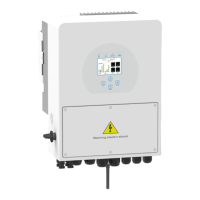

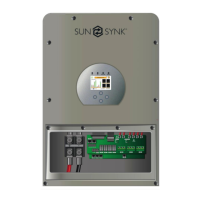
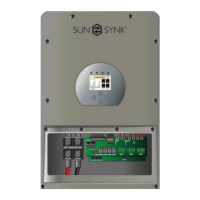
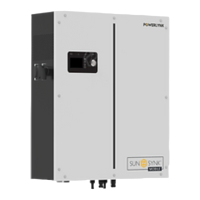
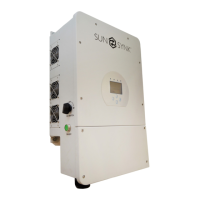


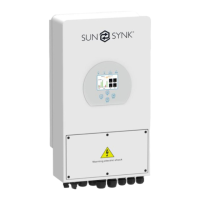
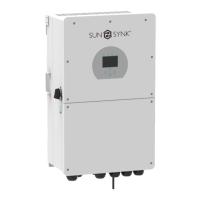
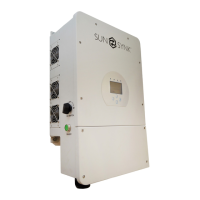
